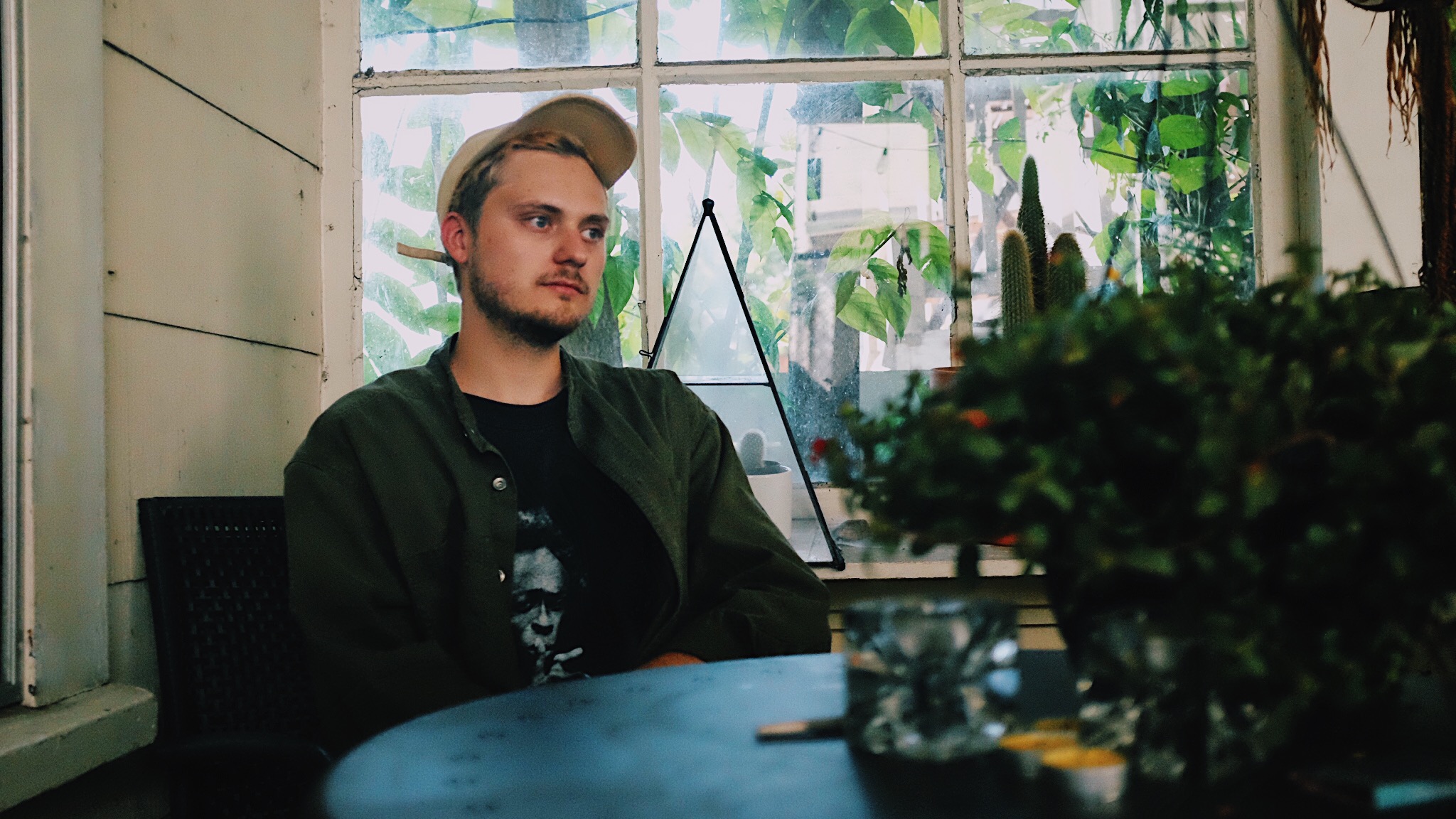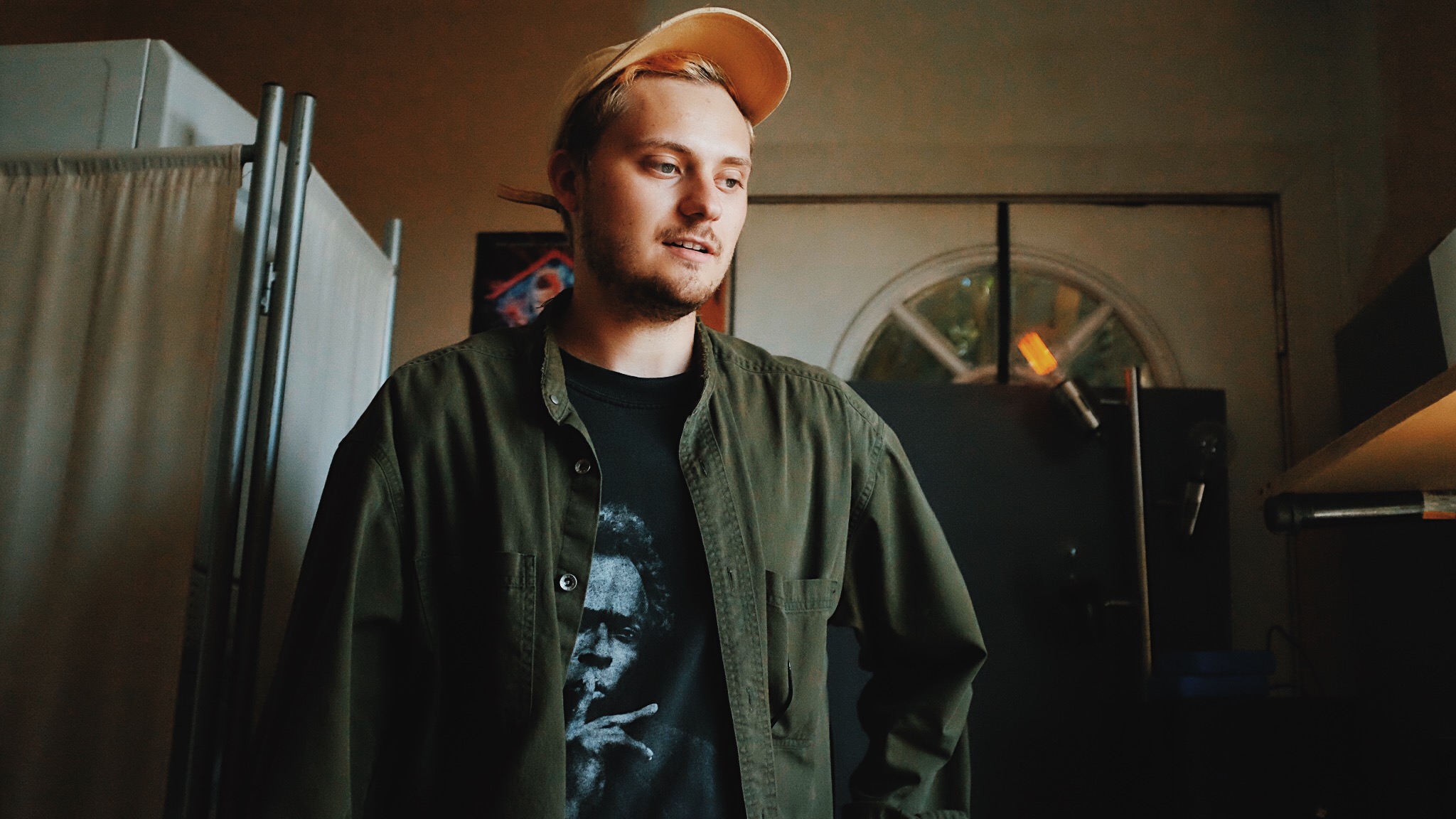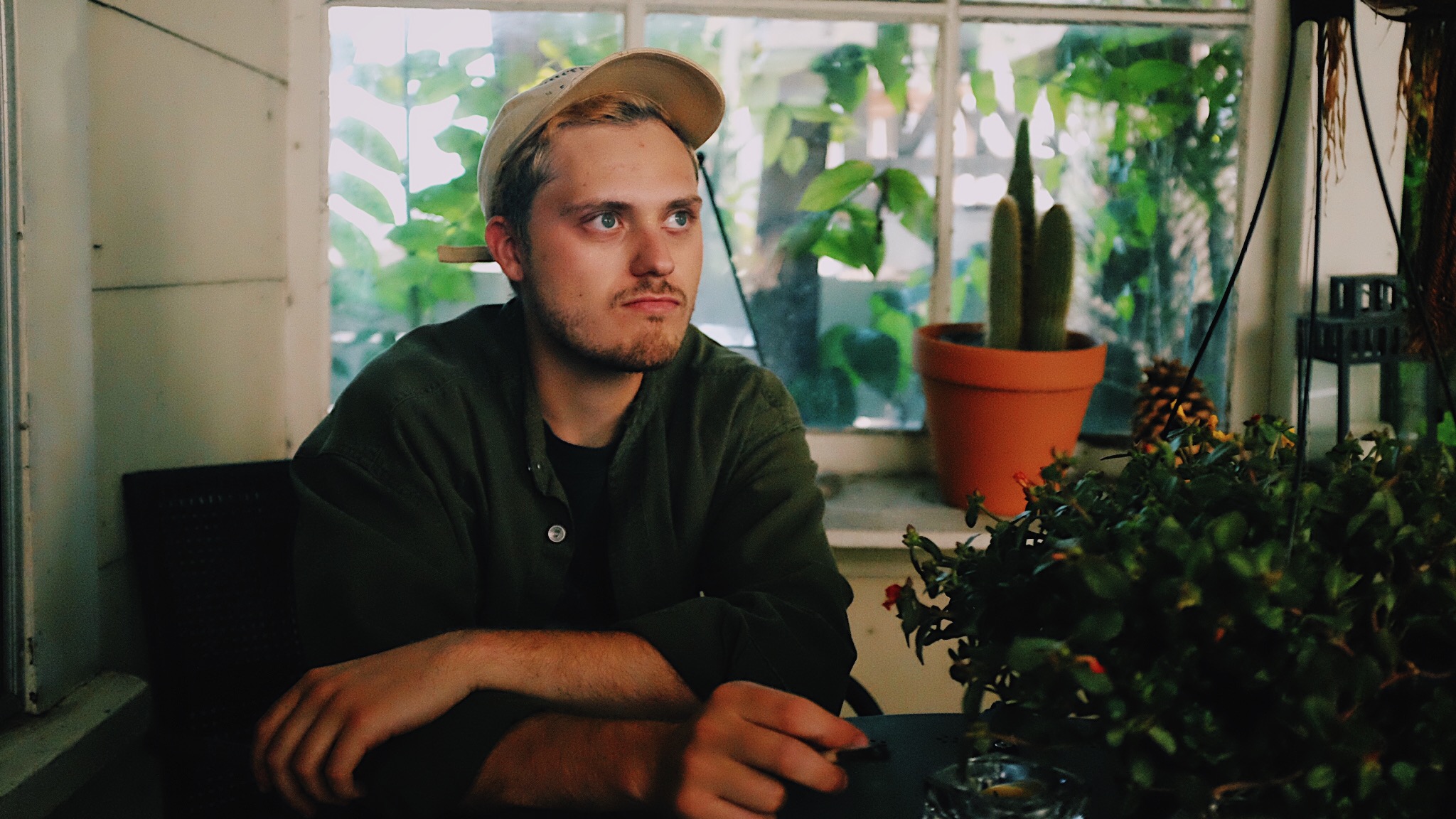Nestled deep inside a garden in Echo Park, an almost half-greenhouse, half-house cottage sits comfortably among what looks like an oasis. On a hot July Sunday afternoon, Carlos Ramirez, known as synth-wave artist Auragraph, takes us into what legit could be a hidden room of secrets: his studio.
“We’re trying to do some chores,” he confesses.
You’d never think of it from the outside, but not only does this beautiful oasis of a home harvest greenery, but also produces some of the most badass block-rockin’ beats. From having his fingerprint on the music for the latest season of Stranger Things, to playing after hour clubs in Los Angeles, Ramirez has operated under Auragraph for some time now, but is still discovering his sound along the way.
He takes us deep inside the abode to a back room that serves as his studio, looking just above the 101 freeway facing downtown. His studio is lined head to toe in synthesizers – some vintage (a Roland SH-101) some new (Moog Mother-32) – all lined up to create a seamless systematic workflow. I ask how long he’s been working on this space.
“Forever… I just keep buying and switching gear. I’m always moving shit in and out,” he admits.
He shows us around his studio taking us to synthesizer after synthesizer. He hits ‘PLAY’ on the 606 drum machine, programming it on the fly. It’s patched into the Roland SH-101, which Auragraph considers to be an essential acid-sounding tool that was originally released as a “budget” synth. “The story on that synth… it was a budget synth that Roland made. They came out at like $300 or $800, and I don’t think it did that well. And then people started finding them in pawn shops for 50 bucks, or in the dumpster.” Apparently, this is the synth that prompted younger producers to take up the acid house sound due to the one of a kind resonator installed in it. They were cheap and accessible, which led to my first official question: if someone wanted to start learning about synthesizers, what direction would you point them in?
“Depends what you wanna get into,” he responds. “In terms of playing chords I’d recommend a low budget polyphonic synth. But if you wanna do basslines, you should get something like the Mother-32.” He powers up the Mother-32, a semi-modular synthesizer, and blasts a fat arpeggiating bassline. “This is a good starting synth ‘cause you can learn basic patching, you have your keyboard, you have all these different control wheels and you can learn what a cut-off filter does and what resonance does, as well as different wave types. And it’s also budget-friendly.”
He also recommends messing around with the Arturia Mini-Brute, which was, ironically, his first synthesizer. As opposed to more modular synthesizers, such as a Eurorack.
“The thing about Euroracks…” he points to a box that has a bunch of knobs and switches on it, “It’s an FM-style synth, instead of a subtractive synth.” He uses the Roland SH-101 as an example. “With subtractive synthesis, you have a filter that takes away harmonics, whereas with FM synthesis, you add harmonics with the resonator section and the FM section, but it can get confusing.”
With FM synthesis, you can take the sound wave and morph it into many different sounds, something that subtractive synths can’t do. He demonstrates, taking a simple pulse width wave on the SH-101 and manipulating it with the resonator and the filter built into the synth through a systematic, left-to-right workflow.
“Every synth is gonna be something different. There’s so many things you can do on the Eurorack that you can’t do on monophonic synths.”

While he’s explaining this, my eye can’t help but fall on the giant reel-to-reel tape machine behind him.
“These things usually go for about $1000,” he says. “But I got this one in Lancaster for $300. What I like to do with tape is, if I have a song in Logic, I can grab the snares and bounce them out into tape and get the characteristics of how tape makes it crunchy and saturated and then put it back into Logic.”
“Pro-Tools vs. Logic vs. Ableton… what’s better?” I ask.
“Oooof…” he responds. “Well, probably Pro-Tools. But Logic is just native to me and easier. It’s just the user-friendliness that makes everything so much easier when you’re producing music.”
Ableton, though, is a different story. “With Ableton you can get super scientific with how you sequence MIDI. You can have all these different MIDI effects that affect sequences differently and approach writing in a different sense from a much more technical standpoint. Whereas Logic is just much more loose. Where you can focus on the music-aspect of it and not so much production. Even though it’s electronic music, it feels more like being in a band where you have your bass track, you have your drum track, you have your lead track… that’s why I like Logic a little more because it’s less intimidating.”
I take a good look around the studio, where everything seems to be at his fingertips with heaps of gadgets and processors and 32-track mixers, I can’t help but ask, “How do you not get overwhelmed?”
“I think it’s really good to just try different things,” he answers mid-smoke. “If I get stuck on a song I’ll just stop working on the song completely and try to make a different sound. Sometimes I’m in the mood to make something pretty low-key, pretty house-y, and sometimes I go in with that intention and it’ll build into something completely different. So I just try to keep an open mind when working and don’t get so set in like ‘Oh I wanna try to make this beat and work with these drums and work with this synth,’ because it’s all experimentation at the end. It helps too if I’m working on a certain tempo, if I’m stuck at 120 and that’s not working, I’ll be like, ‘Okay let me try something naïve, and try a different groove, try some different notes or different scales.’”
“You probably have enough equipment to work with too.” I add. “You have enough routes to travel down.”
“That helps, but I think it’s also good to work within restrictions sometimes,” he replies. “I don’t think I’d expand too much on the synths I have, I’m really comfortable with the setup right now. So anytime I get frustrated with the sound palette, I work with a different type of synth. And I know that every instrument has different things, and there’s kind of a beauty with working that way, because then it’s just ‘Okay I’m only forced to work within this box. How can I try to work outside of that within the means of the synth, or within the means of the song, or the tempo, or whatever, and fill in the gaps in some unique way?'”
In addition to Auragraph, Ramirez also had a hand in the new season of Stranger Things as the score mixing engineer for composers Michael Stein and Kyle Dixon.
He had met them by needing headshots for an old band of his, and had booked a photoshoot with Michael’s partner, Alex, in which they all went to hang out afterward at Echo Park’s Little Joy and kept in touch. They then all worked together on the National Geographic show Valley of the Boom, which Ramirez had done mixing for. “Stranger Things came around and they said ‘Hey we’re gonna need a composer assistant and score mixing engineer, you’ve already worked with our stuff, so are you comfortable jumping into that?’ And I said ‘Yeah, that’d be awesome.’”

He served almost as a composer’s assistant, acting as the middle man between Stein and Dixon and the editors. As the duo were composing, Ramirez would actively mix tracks before sending out the stems to the producers.
It’s hard not to hear the similarities between the show’s soundtrack and Auragraph’s music, which makes it seem like he was a perfect fit for the gig. “I think there’s just a certain kind of texture when you’re working with a lot of these synths,” he adds, “And having the upbeat drum pattern that’s not necessarily as fast as house music but not super slow, just somewhere in the middle and merging the sounds together makes this unique, what some people call minimal wave or synth wave, or whatever, it makes a sound that’s unique in that sense.”
And when asked about how he would describe Auragraph’s music, he took a beat –
“Auragraph is definitely a more upbeat project. I try to have the tempos on the faster side of things, because I want people to have a groove going, to have a pulse. It’s all synthesizer-based stuff whereas my older projects had guitar and real percussion and real drums. So I wanted to brand it as a different name, so ‘Auragraph’ came up. Because this is kind of a different approach to how I’ve always worked on music.”
As opposed to his much cleaner and “brighter” project, Tocaio, Auragraph has a much dirtier sound and texture to it.
“When I got my first synth, I didn’t know anything about synths. I was just playing around with it. I was like ‘this sounds kinda weird…’ but then when I got a Juno-106, that’s when I really thought ‘Okay, now I understand the analog sound. I REALLY like that sound. And I started learning how the envelope section worked, how the filter section worked, how the oscillators worked. How everything worked. And because that synth is so simple, now I can understand a little bit about patching, and I can understand the synths that aren’t as straightforward as the Juno-106… but it’s all from a basic starting point of learning how the waves are formed, and how the waves can be affected through envelopes and filters. But it wasn’t something super easy to learn. It takes time. And that’s why a lot of people don’t get into it because it does take time and it does take money, but also when people are trying to explain it to other people, it can be like they’re speaking a different language.”
Deep inside this greenery of Echo Park, it kind of feels like a new wave is coming. Old fashioned has now become new. We no longer throw out vintage tools just because they’re old, but instead recycle them, and see them as tool-sets.
“At the end of the day, you can learn everything about every synth ever, but, it’s just fun… you just want to get into it because it sounds cool and it’s a unique way to make music, and I think that’s why the community is growing so much, ’cause people just wanna be part of it. It’s a different way to make music. You can make music by yourself with all these different components versus being in a band where you have to rely on other people, and that’s fun too. Everything has its own pros and cons. It’s like everything else, like learning how to play guitar. Or anything. You just kind of learn and keep going with it.”
Auragraph’s debut LP, Memory Tracer, will be available in October via Hiraeth Records on 180-gram vinyl, with cassettes by L.A.’s own Chewing Foil, with a third single to be released September 27th. He’ll be performing at Coaxial in downtown Los Angeles on August 29th, and at Cheer Ups in Austin, TX on October 11th.
His latest singles, “Polywave” and “Drone” are available now on Bandcamp and Spotify.
Peep the album’s tracklist and artwork below:

Featured photos by Gabriel Ovalle
